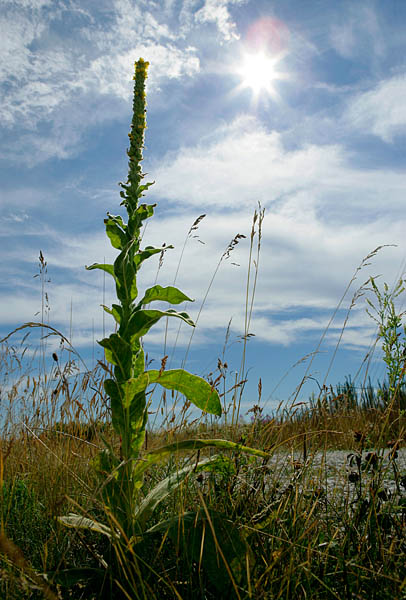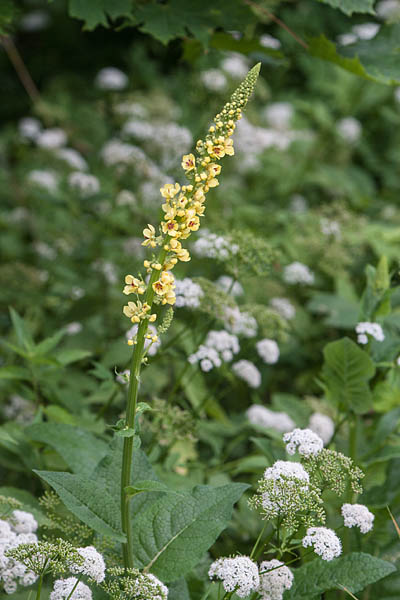Great mullein Üheksavägine Verbascum thapsus
With its powerful exterior and legendary healing properties the great mullein that belongs to the figwort or Scrophulariace family is only a biennial plant. In the first year of growth those who know notice only a nice circle of leaves covered with grey hairs and in the same summer of growth the plant collects nutrition stores into its root system. In the second year a stem with velvety leaves without stalks rises from the centre of the rosette stretching into the heights and with many yellow flowers in the upper part. Even in good habitats only up to some tens of plants grow. In a large vase the flower keeps well, all the time opening up new flowers.
After flowering and the ripening of the seeds the plant ends its life cycle. The mulleins have a number of different techniques for keeping the species alive. Out of the great number of its seeds only a few will sprout the next spring; the rest stay in the soil waiting and that if needed for centuries. From the fertilized flowers a capsule develops that contains up to a hundred fifty thousand seeds.
The dry, pebbly habitats with sandy soils in northern and western
In our nature you can meet two figwort family species: in addition to the common mullein also the dark mullein and moreover also a rarely occurring hybrid .
Dark mullein
Dark mullein Must vägihein Verbascum nigrum
In folk medicine the dark mullein was considered as less valuable. But outwardly they are similarly noticeable by their length that in both cases can easily reach up to a metre and a half.
How to distinguish the dark mullein from the common or great mullein that we have already described?
Firstly look at the leaves, they are a clear green, rounded and with stalks (velvety for the common mullein and the leaf turns into a leaf stem and is kept upwards-pointing).
Looking at an individual flower – the filaments of the stamens are covered with long violet hairs (white for the common or great mullein).
Earlier we mentioned that these plants hybridize given the chance and the hybrid gets the intermediate characteristics of both species; this plant has even been given an Estonian name: kink-vägihein.
The dark mullein is not a long-lived plant, rather a two-year-old or a little more and in the first year the plant grows a leaf rosette quite as the common mullein. In the second year comes the inflorescence, up to half a metre long, on top of a reddish, hairy and furrowed stem where the flowers are attached to the stem by pairs or up to five at a time. The seed yield may be estimated as more than half less than for the common mullein.
Despite the abundant amount of seeds the dark mulleins mostly grow solitarily. Interesting why?




